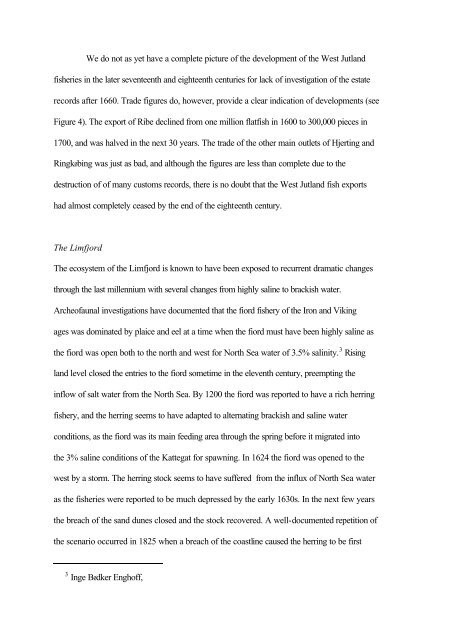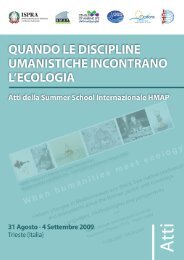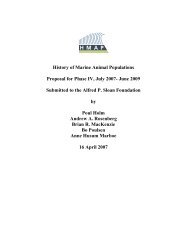The Danish fisheries c.1450-1800. Medieval and early modern ...
The Danish fisheries c.1450-1800. Medieval and early modern ...
The Danish fisheries c.1450-1800. Medieval and early modern ...
Create successful ePaper yourself
Turn your PDF publications into a flip-book with our unique Google optimized e-Paper software.
We do not as yet have a complete picture of the development of the West Jutl<strong>and</strong><br />
<strong>fisheries</strong> in the later seventeenth <strong>and</strong> eighteenth centuries for lack of investigation of the estate<br />
records after 1660. Trade figures do, however, provide a clear indication of developments (see<br />
Figure 4). <strong>The</strong> export of Ribe declined from one million flatfish in 1600 to 300,000 pieces in<br />
1700, <strong>and</strong> was halved in the next 30 years. <strong>The</strong> trade of the other main outlets of Hjerting <strong>and</strong><br />
Ringkøbing was just as bad, <strong>and</strong> although the figures are less than complete due to the<br />
destruction of of many customs records, there is no doubt that the West Jutl<strong>and</strong> fish exports<br />
had almost completely ceased by the end of the eighteenth century.<br />
<strong>The</strong> Limfjord<br />
<strong>The</strong> ecosystem of the Limfjord is known to have been exposed to recurrent dramatic changes<br />
through the last millennium with several changes from highly saline to brackish water.<br />
Archeofaunal investigations have documented that the fiord fishery of the Iron <strong>and</strong> Viking<br />
ages was dominated by plaice <strong>and</strong> eel at a time when the fiord must have been highly saline as<br />
the fiord was open both to the north <strong>and</strong> west for North Sea water of 3.5% salinity. 3 Rising<br />
l<strong>and</strong> level closed the entries to the fiord sometime in the eleventh century, preempting the<br />
inflow of salt water from the North Sea. By 1200 the fiord was reported to have a rich herring<br />
fishery, <strong>and</strong> the herring seems to have adapted to alternating brackish <strong>and</strong> saline water<br />
conditions, as the fiord was its main feeding area through the spring before it migrated into<br />
the 3% saline conditions of the Kattegat for spawning. In 1624 the fiord was opened to the<br />
west by a storm. <strong>The</strong> herring stock seems to have suffered from the influx of North Sea water<br />
as the <strong>fisheries</strong> were reported to be much depressed by the <strong>early</strong> 1630s. In the next few years<br />
the breach of the s<strong>and</strong> dunes closed <strong>and</strong> the stock recovered. A well-documented repetition of<br />
the scenario occurred in 1825 when a breach of the coastline caused the herring to be first<br />
3 Inge Bødker Enghoff,






